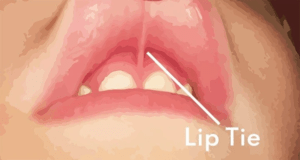Baby Frenulum Between Front Teeth: Causes & Solutions
- Dr Owais Rafiq
- November 11, 2024
- 3:44 pm

Baby Frenulum Between Front Teeth | Causes, Symptoms, and Solutions
A baby frenulum between the front teeth causes concern in most parents as they notice there is a gap between the two upper teeth. This often turns out to be a normal phenomenon and not harmful; however, knowledge of the causes and possible remedies is essential to support your child’s dental development.
If you are ever wondering whether this will even affect the smile of your child or oral health over the long run, then this article makes an in-depth exploration of the subject of what a frenulum is, when intervention might be necessary, and the treatment options available.
What is a Frenulum?
A frenulum is a small piece of tissue connecting the upper lip to the gums just above the front teeth. It extends below the norm in some babies, so there is an evident gap between the two upper front teeth. It is sometimes called a “labial frenulum” or “lip tie.” The appearance of a gap between the front teeth does raise some questions, but in infants, it is a rather common occurrence and generally not a cause for concern. Sometimes this gap is only temporary, and the frenulum will not cause any long-term dental issues for most babies.

A frenulum is generally made of a piece of fibrous tissue that works as the anchor of the lip, but if it is rather thick or tight, it may impinge upon the teeth. This tissue, if it is too long, can cause the teeth not to meet properly and will thus result in a noticeable space between the upper front teeth. Although this condition is generally harmless, it can sometimes be an issue for parents who find that this condition creates developmental problems or proves problematic later in their child’s life.
Why Does a Frenulum Cause a Gap?
A baby frenulum between the front teeth occurs when the frenulum extends lower than is normal, in most cases, making there appear to be a considerable gap between two upper front teeth. The tissue might prevent the teeth from meeting and cause quite a noticeable gap, especially in infants and young children.

Several factors could contribute to this condition, and though frightening at first; usually, there is no reason to panic about it. It is typically more cosmetic than anything else and, in most situations, the gap will close up on its own as the child develops and their teeth are fully formed.
- Genetics: Usually, the presence of a frenulum gap is genetic. If one or both of the parents or family members had the same problem, their child could be equally affected. Genetics play a role in determining the development of the frenulum.
- Developmental Factors: The frenulum might just be longer than usual when one is an infant, thereby causing the space. The situation, however, might change when one grows to become a mature person as the frenulum decreases to allow closer separation of the teeth.
- Delayed Emergence of the Teeth: The other contributing factor that might lead to the development of a frenulum gap is the delayed emergence of the front upper teeth. At times, for example, front upper teeth may emerge later, and the frenulum, in this interlude, will cause a shift in the position of the front upper teeth.
Is a Frenulum Between the Teeth Harmful?
For the most part, an interdental frenulum between the front teeth is painless and harmless to the overall health or well-being of a child. Such a condition will not generally be associated with any type of severe discomfort or pain and does not interfere with the normal eating, talking, or breathing capabilities of the child. Children’s dental development usually resolves problems related to the frenulum as the children grow, and the gap may close on its own.

This spacing can carry over into early adolescent years or even past it, into adulthood in rare cases. If left unpunctured, then it needs treatment to align the teeth or correct aesthetic issues. Apart from that, the frenulum causes a condition in terms of “diastema,” where the front pair of upper teeth become diagonally spaced.
Treatment Options for Baby Frenulum Between Teeth
In general, intervention in case of the frenulum or the gap between two teeth in a baby is not required at first. They are mostly advised by their doctors or other caregivers to observe their child’s dental progress. However, when the space between the baby’s teeth remains that way and causes trouble later in life, then there are various options available for fixing this condition.
-
Observation
In most circumstances, the cleft of the frenulum will gradually heal as the child grows, develops teeth and has his jaws developed. Sometimes, as the baby grows and gets to the stage of developing all his or her permanent teeth, the two front teeth might close up on their own accord. For parents, the best advice is to watch the gap over time because changes are most likely to present during the initial years of the child’s life.
-
Frenectomy
In cases of particularly tight or thick frenulum, a frenectomy may be suggested. This consists of operations that include cutting or even mobilization of the frenulum with the aim of achieving correct arching of the teeth. A frenectomy is also not a complex surgery and the surgery is relatively fast, which could be carried out at a dentist’s office wearing local anesthesia. Or the gap may close more easily, and the child’s teeth can finally start to grow straight after the treatment.
-
Orthodontic Treatment
If, however, this gap remains unfilled up until adolescence or adulthood, the patient should seek orthodontics – and specifically orthodontic treatment with braces. These can also close any residual gaps while orthodontic devices help with the correct alignment of the teeth. Orthodontic treatment is typically indicated if the gap affects the overall look of the smile, or the problem persists to impair the bite.
-
Speech and Feeding Therapy
In rare instances, the frenulum can impede speech or feeding, especially in cases where its presence limits the upper teeth to closure. If this is so, speech or feeding therapy should be provided to the child to help him develop proper oral motoric. This might give the parents some hope that their child’s means of speaking and eating would not be affected by the frenulum.
Home Care
For most infants, a frenulum between their front teeth is not cause for alarm and does not need immediate treatment. However, certain things can be done by parents to support their child’s dental development:
-
Preach Good Oral Hygiene Practices
That being the case, despite such a gap proper oral care should not be overlooked. Parents should give dental care to their little ones and young children. They must brush their teeth at least twice a day with a non-bristle, small-headed ‘kiddies’ toothbrush and fluoride toothpaste. This will go a long way in preventing tooth decay and maintenance of teeth health as the kids may do it through their developmental stages.
-
Dental Check-Ups
Regular check-up of the teeth and gums helps monitor the changes resulting from the erupting teeth. Thus, the dentist can assess the situation and advise on whether some treatment or intervention is necessary. There is an advantage in taking action against a problem at an early stage.
-
Discourage Pacifiers and Thumb Sucking
This is particularly important for a child who suckles a pacifier or thumb because such habits worsen the dental gaps, especially the spaces between the fore teeth. Such habits should be controlled and discouraged at a young age for healthy teeth development.
When to Seek Professional Help
If the gap between your child’s two front teeth closes together fast or if there are any concerns regarding the child’s progress dentally, it is better to seek the opinion of a dentist. Such a specialist can assess the condition and propose measures to be taken. When necessary, the children’s dentist may also direct you to an orthodontist for further treatment.
FAQs
-
Can a frenulum gap affect speech development?
In most cases, a frenulum gap does not impact speech development. However, if the gap is part of a more significant issue with tooth alignment or oral motor function, a speech therapist may be able to assist with any difficulties.
-
Is a frenulum between the teeth a hereditary condition?
Yes, a frenulum gap can be inherited. If a parent or close family member has a similar condition, their child may develop the same gap.
-
Can a frenulum gap close on its own?
Most of the time, such gaps are filled automatically when the permanent teeth grow in. But if the gap remains even in the teenage years, there are chances that corrective treatment such as braces or frenectomy is required.
Dr Owais Rafiq
Subscribe to Dr Owais YouTube channel
For parenting advice, child health, symptoms, causes and treatment of illness in children.





